Scientific name: Eriogonum umbellatum
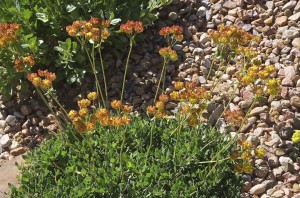
Eriogonum umbellatum in mid summer (Photo by Janice Tucker)
Common name: sulphur flower
Plant Family: Polygonaceae – buckwheat
Text and Photos by Janice Tucker
The Eriogonum umbellatum (sulphur flower) may grow low to the ground but it is impossible to ignore. The extroverted, bright yellow or red-orange flowers, swaying atop tall, slender stems literally wave in the breeze to grab the attention of passersby, be they human, butterflies, bees or birds.
The E. umbellatum is a perennial that is native to the Rocky Mountain area of the United States and southwest Canada, thriving in areas with cold winters. According to Flora of North America there are 41 varieties of the Eriogonum umbellatum. It grows naturally in foothills, dry meadows and mountains. These varied conditions of soil composition, water, elevation and climate trigger a “survive or die syndrome”. And the E. umbellatum is a survivor that strives to adapt to its habitat. It’s one of those “bloom where you’re planted” types. This adaptability to their environment can result in the plants developing slightly different characteristics where they grow, making positive plant identification difficult.
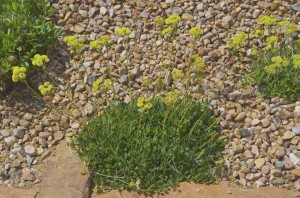
Eriogonum umbellatum spring (Photo by Janice Tucker)
Although the E. umbellatum’s many varieties and subspecies grow from 3 inches to 3 feet in height, all varieties form loose mats of leaves. The variety in the Botanical Garden at Museum Hill hugs the ground with round clumps of green, spoon-shaped leaves that have gray-green, wooly undersides. Leaf-like bracts also appear on the stems just beneath the umbels (flowering clusters). In spring many umbels of small, bell-shaped, yellow flowers are borne on stems that rise 6 to 12 inches above the basal leaves. Each flower in the umbel has 6 tiny petals. Over the next few months the yellow flowers gradually segue into a mix of yellow and red-orange. As the flowers and leaves continue to age, they become an attractive red that eventually turn a handsome brown by the end of autumn. It is a larval host and nectar source of the Lupine Blue butterfly. The Rocky Mountain Dotted-blue butterfly as well as other butterfly species and bees are attracted to its nectar. Birds and small wildlife enjoy dining on the seeds.
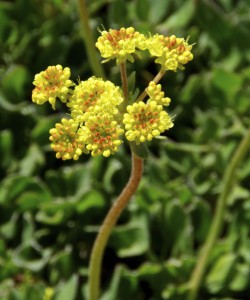
Eriogonum umbellatum close up of umbels (Photo by Janice Tucker)
The E. umbellatum prefers full sun or partial shade, gravelly soils and very little supplemental water after it is established. It is a low maintenance plant that is right at home in borders and rock gardens. Because of its preference for dry climates, it does well in xeric gardens. Propagation is by seed since its deep taproot makes transplanting difficult. Sowing the seeds thickly is recommended since germination is usually low. A three-month stratification of the seeds may help with germination. But unless propagation is a passion, do yourself a favor and purchase plants from a reputable nursery that can ensure that the variety chosen is right for your location.
The common name of sulphur flower refers to the bright yellow flowers. The genus, Eriogonum (er-ih-OG-uh-num), is a compound Greek word of erion (wool) and gony (knee), which describes the soft, wooly leaves and the bumpy nodes that are often indicative of species in the buckwheat family. Umbellatum (um-bell-AY-tum) refers to the flower umbels at the end of each long stem. John Torrey named this species in 1897.
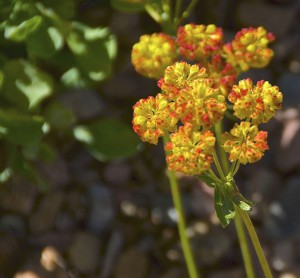
Eriogonum umbellatum red orange flower clusters in summer (Photo by Janice Tucker)
E. umbellatum is among plants that are chosen for land reclamation projects such as overgrazed rangelands. Native Americans made various decoctions to treat ailments such as rheumatism, stomachaches and pain. It has also been used as a disinfectant. The E. umbellatum flower keeps its shape as it dries and is often used in floral arrangements.
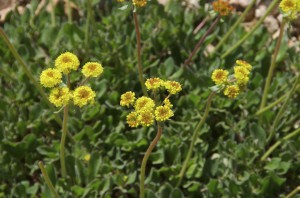
Eriogonum umbellatum waving in the wind (Photo by Janice Tucker)
Planting Eriogonum umbellatum will add a friendly touch to your garden, inviting bees and butterflies to dine, and waving at people to make them smile while admiring this cheerful plant.
Sources Consulted:
Allred, Kelly W., Flora Neomexicana II: Glossarium Nominum – A Lexicon of New Mexico Plant Names, Range Science Herbarium, Department of Animal & Range Sciences, New Mexico State University, Las Cruces, New Mexico, Copyright 2009 by Kelly W. Allred.
Craighead, John J., Craighead, Frank C., Jr., and Davis, Ray J., Peterson Field Guides, Rocky Mountain Wildflowers, Houghton Mifflin Company, 215 Park Avenue South, New York New York, 10003, Copyright 1991 by John J. Craighead, Frank C. Craighead, Jr., and Ray J. Davis.
Dave’s Garden, Welcome to Botanary, http://davesgarden.com/guides/botanary/.
Flora of North America Editorial Committee, eds. 1993+. Flora of North America North of Mexico. 18+ vols. www.efloras.org, New York and Oxford.
Missouri Botanical Garden, Plant Finder – Eriogonum umbellatum, www.missoruibotanicalgarden.org.
Parris, C., Shock, C.C, Feibert, E, and Shaw, N. Sustainable Agricultural Techniques: Native Plant Seed Production – Sulphur-flower Buckwheat – Eriogonum umbellatum (ERUM), Oregon State University, http://ir.library.oregonstate.edu/xmlui/bitstream/handle/1957/19598/em9017.pdf
Published December 2010, Copyright 2010 by Oregon State University.
Schneider, Al, Eriogonum umbellatum (Sulphur Flower), Southwest Colorado Wildflowers, www.southwestcoloradowildflowrs.com.
Spellenberg Richard, National Audubon Society, Field Guide to Wildflowers, Western Region, Revised Edition Alfred A. Knopf, Inc, New York, New York, Copyright 2001 by Chanticleer Press, Inc.
Stearn, William T., Stearn’s Dictionary of Plant Names for Gardeners, A Handbook on the Origin and Meaning of the Botanical Names of some Cultivated Plants, Cassell Wellington House, 125 Strand, London WC2R OBB, 1996.
Thanks to Helen Woody for proofreading this article.


